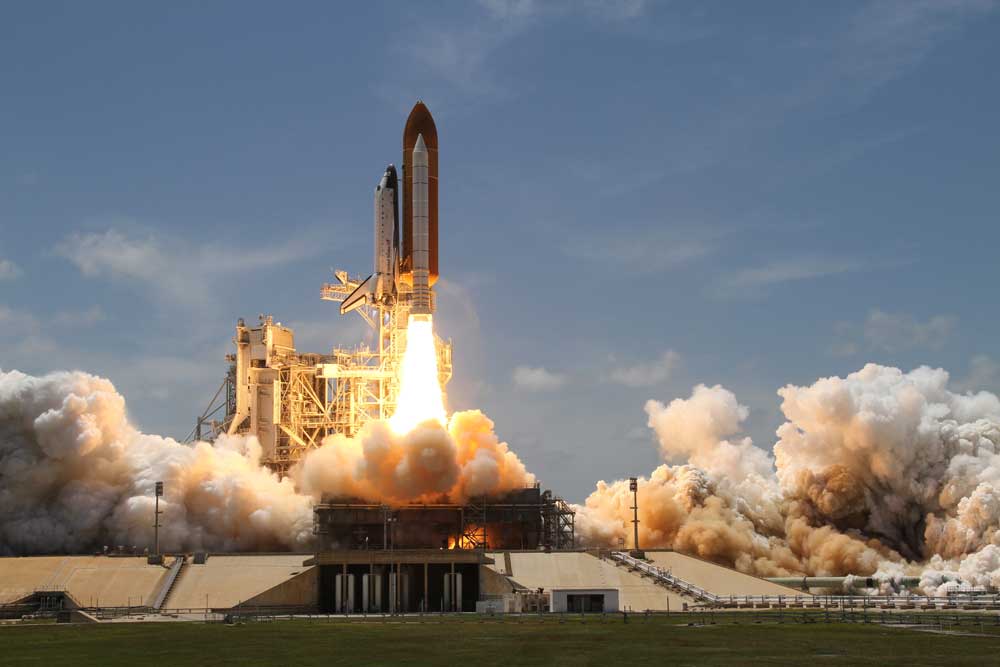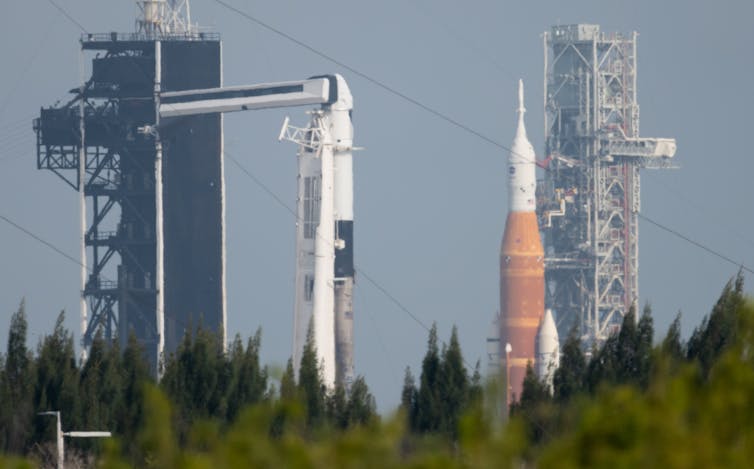
By Michael Dodge
I love a good space launch, and I have been eagerly awaiting NASA’s powerful new Space Launch System rocket to take off as the first part of NASA’s ambitious Artemis Mission to put U.S. astronauts back on the Moon. But this launch has already been pushed back four times this year – twice due to technical issues and once apiece for a tropical storm and a hurricane.
I am a professor of space studies who teaches courses in space law and history. One lesson I’ve learned is that as successful as the U.S. and other nations have been at launching rockets into space over the decades, a huge number of launches get delayed due to weather or safety concerns. Of NASA’s 135 Space Shuttle missions, only about 40% launched on time.
While Artemis 1 is continuing the long tradition of delayed NASA launches, there are good reasons for the high level of caution that underlies these delays. But as private space launch activities continue to grow, the odds of watching an on-time launch are slowly improving.
Delays, scrubs and safety
Launches that don’t go off on time are classified as either postponements, scrubs or delays. Postponements refer to pushing a planned launch date back to a later date. Scrubs are when a mission is halted on the day the launch is supposed to occur and rescheduled for a later date. Scrubs are usually a last-minute decision triggered by bad weather or mechanical issues causing safety concerns. A delay is when a launch occurs later in a day than originally planned, but does happen in the same day.
The ill-fated launch of the space shuttle Challenger in January 1986 experienced all of these hold-ups. First, the mission experienced two postponements for a total of three days to accommodate the landing of the space shuttle Columbia. The launch was also scrubbed twice due to weather and technical problems, and finally the mission experienced two delays on the day of the actual launch. Sadly, the shuttle and astronauts aboard were lost in an explosion 74 seconds after launch.
This first Artemis launch has experienced both postponements and scrubs, but part of the reason there have been such long stretches of time between launch attempts is due to the concept of launch windows. Due to the rotation of the Earth and position of the Moon, launching a rocket at certain times requires substantially less fuel than launching at other times. If a launch misses its window, you usually can’t simply launch again the next day.
While the repeated postponements and scrubs of Artemis 1 are disheartening, these delays are for good reason. NASA wants to ensure a safe and successful mission.
A culture of safety
Postponements, scrubs and delays tend to occur due to bad weather conditions, mechanical issues or health concerns of the crew – any of which could threaten the safety of the craft and the people aboard. NASA has learned the hard way to be cautious of these scenarios.
The first lesson came in January 1967, during a test for the Apollo 1 mission. The rocket in question was meant to go on an early test flight for the first U.S. missions to the Moon. Astronauts Ed White, Roger Chaffee and Gus Grissom were all killed when a fire started in the crew cabin during a launch pad test. After the tragedy, NASA created its Office of Flight Safety.
Most of NASA’s launches went well after the Challenger disaster. But the breakup of shuttle Columbia after entering the Earth’s atmosphere in February 2003 was a notable exception that killed all seven astronauts onboard. That disaster in particular caused NASA to pause operations and take stock of its launch strategies. In a truly stinging report from an internal investigation, NASA highlighted its own “broken safety culture” and a failure to learn from the mistakes of the Challenger disaster.
In the years since, NASA has demonstrated a concerted effort to learn from the mistakes of the past. It’s not surprising that it will delay launches if there is a need to check on the safety of craft or crew.

NASA/Joel Kowsky
Contemporary trends
Space launches are happening more frequently every year. This increase is mostly driven by the rise of private space companies like SpaceX serving as re-suppliers for the International Space Station and carrying satellites into orbit. All signs suggest that the upward trend in launches will continue.
Unlike government agencies, private launch companies have a strong profit motive to launch frequently. While specific data on private industry’s launch schedules is hard to come by, it does seem that, more often than not, SpaceX launches, for example, go off on time. This may be due to the fact that the high volume of launches using the Falcon9 rocket – around 50 this year alone – has given the company’s engineers plenty of time to iron out mechanical issues. While other companies trail SpaceX in volume, they are catching up. Blue Origin, for example, completed its 22nd mission to space in August 2022, carrying six passengers.
Despite their general success, private companies are not immune to technical issues, weather or health concerns that can lead to postponements, scrubs or delays. In early October 2022, SpaceX scrubbed a launch of one of its Falcon9 rockets to allow for additional vehicle inspections. SpaceX also postponed a launch due to the same hurricane that has pushed back Artemis again. And in 2021, a launch was delayed when a medical issue came up with one of the NASA astronauts that was bound for the International Space Station.
As more rockets get lined up for both governmental and private needs, delays and scrubs for launches will continue to be a fact of life for anyone launching rockets to space. The feeling of tension, frustration and excitement that I feel when waiting to see that brilliant flash of ignition and a rocket headed to the heavens is a feeling many have endured. During the long delay for the 1961 Freedom 7 Mercury mission, astronaut Alan Shepard was strapped in his capsule with little to do but wait for several hours. Eventually he got fed up and told NASA to “fix your little problem and light this candle.” After a while, NASA gave the go-ahead, and Shepard became the first American to fly to space.
![]()
Michael Dodge is Associate Professor of Space Studies, University of North Dakota.





























Leave a Reply